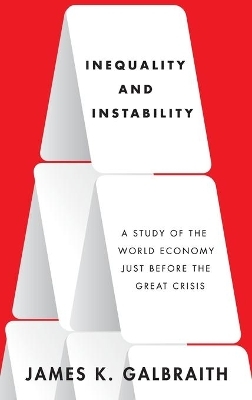
Inequality and Instability
Oxford University Press Inc (Verlag)
978-0-19-985565-0 (ISBN)
In Inequality and Instability, James K. Galbraith argues that since there has been no serious work done on the macroeconomic effects of inequality, new sources of evidence are required. Galbraith offers for the first time a vast expansion of the capacity to calculate measures of inequality both at lower and higher levels of aggregation. Instead of measuring inequality as traditionally done, by country, Galbraith insists that to understand real differences that have real effects, inequality must be examined through both smaller and larger administrative units, like sub-national levels within and between states and provinces, multinational continental economies, and the world. He points out that inequality could be captured by measures across administrative boundaries to capture data on more specific groups to which people belong. For example, in China, economic inequality reflects the difference in average income levels between city and countryside, or between coastal regions and the interior, and a simple ratio averages would be an indicator of trends in inequality over the country as a whole. In a comprehensive presentation of this new method of using data, Inequality and Instability offers an unequaled look at the US economy and various global economies that was not accessible to us before. This provides a more sophisticated and a more accurate picture of inequality around the world, and how inequality is one of the most basic sources of economic instability.
James K. Galbraith is the Lloyd M. Bentsen Jr. Chair in Government/Business Relations and Professor of Government at the LBJ School of Public Affairs at the University of Texas. He is the author most recently of The Predator State: How Conservatives Abandoned the Free Market and Why Liberals Should Too
Chapter 1. The Physics and Ethics of Inequality ; 1. The Simple Physics of Inequality Measurement ; 2. The Ethical Implications of Inequality Measures ; 3. Plan of the Book ; References ; Chapter 2. The Need for New Inequality Measures ; 1. The Data Problem in Inequality Studies ; 2. Obtaining Dense and Consistent Inequality Measures ; 3. Grouping Up and Grouping Down ; 4. Conclusion ; References ; Chapter 3: Pay Inequality and World Development ; 1. What Kuznets Meant ; 2. New Data for a New Look at Kuznets' Hypothesis ; 3. Pay Inequality and National Income: What's the Shape of the Curve? ; 4. Global Rising Inequality: the Soros Super-bubble as a Pattern in the Data ; 5. Conclusion ; References ; Appendix: On a Presumed Link from Inequality to Growth ; Chapter 4. Estimating the Inequality of Household Incomes ; 1. Estimating the Relationship Between Inequalities of Pay and Income ; 2. Finding the Problem Cases: A Study of Residuals ; 3. Building a Deep and Balanced Income Inequality Data Set ; 4. Conclusion ; References ; Chapter 5. Economic Inequality and Political Regimes ; 1. Democracy and Inequality in Political Science ; 2. A Different Approach to Political Regime Types ; 3. Analysis and Results ; 4. Conclusion ; References ; Appendix I: Political Regime Data Description ; Appendix II: Results Using Other Political Classification Schemes ; Chapter 6. The Geography of Inequality in America, 1969 to 2007 ; 1. Between-Industry Earnings Inequality in the United States ; 2. The Changing Geography of American Income Inequality ; 3. Interpreting Inequality in the United States ; 4. Conclusion ; References ; Chapter 7: State-Level Income Inequality and American Elections ; 1. Some Initial Models Using Off-the-Shelf Data for the 2000 Election. ; 2. New Estimates of State-Level Inequality and an Analysis of the Inequality-Elections Relationship over Time ; 3. Inequality and the Income Paradox in Voting ; 4. Conclusion ; References ; Chapter 8. Inequality and Unemployment in Europe: A Question of Levels ; 1. An Inequality-based Theory of Unemployment ; 2. Region-based Evidence on Inequality and Unemployment ; 3. Inequality and Unemployment in Europe and America ; 4. Implications for Unemployment Policy in Europe ; References ; Appendix. Detailed Results and Sensitivity Analyses ; Chapter 9. European Wages and the Flexibility Thesis ; 1. The Problem of Unemployment in Europe: A reprise ; 2. Assessing Wage Flexibility Across Europe ; 3. Clustering and Discriminating to Simplify the Picture ; 4. Conclusion ; References ; Appendix A: Cluster Details ; Appendix B: Eigenvalues and Canonical Correlations ; Appendix C: Correlations between Canonical Scores and Pseudoscores ; Chapter 10: Globalization and Inequality in China ; 1. The Evolution of Inequality in China through 2007 ; 2. Finance and the export boom, 2002 to 2006 ; 3. Trade and capital inflow in post-WTO China ; 4. Profit and Capital Flows into Speculative Sectors ; 5. Conclusion ; References ; Chapter 11. Finance and Power in Argentina and Brazil ; 1. The Modern Political Economy of Argentina and Brazil ; 2. Measuring Inequality in Argentina and Brazil ; 3. Sources of Data ; 4. Pay Inequality in Argentina 1994-2007 ; 5. Pay Inequality in Brazil 1996-2007 ; 6. Conclusion ; References ; Chapter 12. Inequality in Cuba After the Soviet Collapse ; 1. Data on Pay in Cuba ; 2. Evolution of the Cuban Economy 1991 - 2005 ; 3. Cuban Pay Inequality by Sector ; 4. Cuban Pay Inequality by Region ; 5. Conclusion ; References ; Chapter 13: Economic Inequality and the World Crisis ; Bibliography
| Erscheint lt. Verlag | 3.5.2012 |
|---|---|
| Zusatzinfo | 59 black and white line drawings |
| Verlagsort | New York |
| Sprache | englisch |
| Maße | 236 x 163 mm |
| Gewicht | 612 g |
| Themenwelt | Geschichte ► Teilgebiete der Geschichte ► Wirtschaftsgeschichte |
| Wirtschaft ► Allgemeines / Lexika | |
| Wirtschaft ► Volkswirtschaftslehre ► Finanzwissenschaft | |
| Wirtschaft ► Volkswirtschaftslehre ► Makroökonomie | |
| Wirtschaft ► Volkswirtschaftslehre ► Ökonometrie | |
| ISBN-10 | 0-19-985565-X / 019985565X |
| ISBN-13 | 978-0-19-985565-0 / 9780199855650 |
| Zustand | Neuware |
| Haben Sie eine Frage zum Produkt? |
aus dem Bereich


